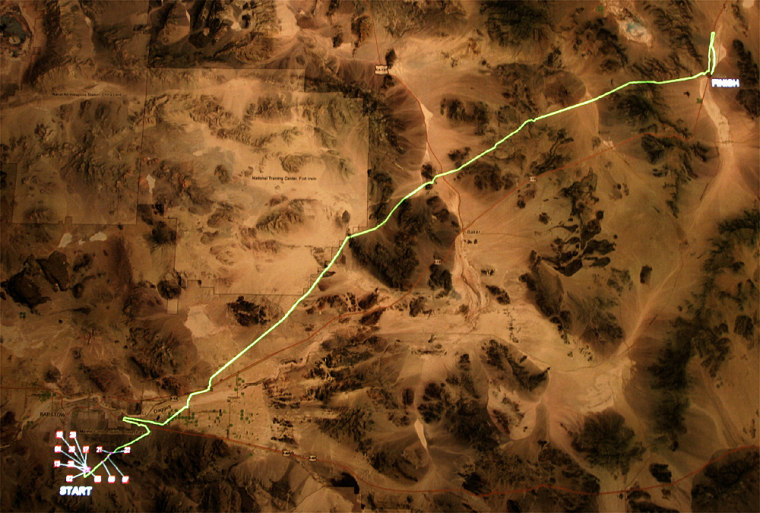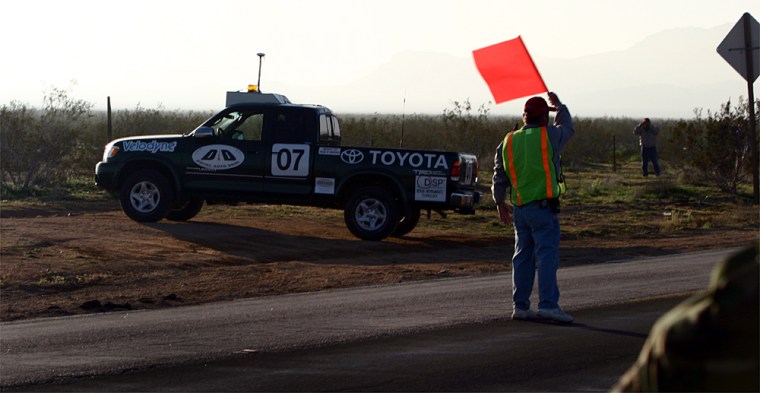Based on the numbers, the Pentagon’s first-ever robotic road race looks like a bust: No one won the $1 million offered as a prize. In fact, every one of the 15 autonomous vehicles broke down or withdrew within the first four hours of what was expected to be a 10-hour race. The hardiest robot made it through only 7.4 miles of the 142-mile course.
But most of the competitors, as well as the government agency that paid for the DARPA Grand Challenge, hailed Saturday’s event as a success.
“We came this far — we’ve won,” said 17-year-old Chris Seide, a member of the Palos Verdes High School Road Warriors, whose converted SUV crashed into the starting chute’s barriers twice during the morning.
The Defense Advanced Research Projects Agency has already gotten a fourfold or fivefold return on its $13 million investment in the yearlong process, said Anthony Tether, DARPA’s director. He said the innovations demonstrated over the past week would help the U.S. military push toward its goal of having a third of its vehicles operate autonomously by 2015.

“We did what we wanted to do,” Tether told journalists in Primm, the intended endpoint of the race, “but that doesn't mean that we aren't going to keep coming back and keep doing this until somebody picks up that million-dollar check.”
Sandstorm, the converted Humvee military vehicle entered by Carnegie Mellon University’s Red Team, was the favorite in the race — and it ended up going the farthest, racking up 7.4 miles. The vehicle, which had suffered a rollover during a practice session last week, hit a couple of posts early on Saturday’s course, and spun out several miles later as it was climbing a rugged switchback.
The failing might have been the result of a sensor glitch that went uncorrected after the earlier rollover, or damage done during the crash on the course, or merely a turn of bad luck. DARPA’s Tether told journalists that if Sandstorm had driven just 6 inches closer to the inboard side of the switchback, it might have kept on going.
Red Whittaker, a Carnegie Mellon robotics professor and the Red Team’s leader, took the apparent mechanical failure in stride.
“If you haven’t done everything, you haven’t done anything,” he told MSNBC.com. “It doesn’t matter if it’s a flipped bit, or a bad sensor, or a lug nut. They’re really all the same.”
He said Sandstorm’s performance showed that the machine had “as much heart as the team.”
“Sandstorm will ride again,” he declared.
The day promised to be a marathon: At 3:20 a.m. PT Saturday, competitors received 229,000 GPS coordinates defining the course between the makeshift starting-line arena in the Mojave Desert, outside Barstow, Calif., and the finish line at Primm, about 35 miles south of Las Vegas.
Whittaker said the team’s computers calculated the first “solution” for the trip within 10 minutes, and had a winning strategy by 4 a.m. Sandstorm also had the advantage of the earliest start, at 6:30 a.m., but by 7:10 a.m. it was all over for the vehicle.
The ones that followed could do no better: Team SciAutonics II’s converted dune buggy got hung up on an embankment after 6.7 miles. Team D.A.D.’s robo-Toyota truck paused after 6 miles and couldn't get started again. The Golem Group's pickup was stymied by a steep hill after 5.2 miles. Team ENSCO’s buglike all-terrain vehicle zipped down the course’s first straightaway — then flipped over.
Some of the others could hardly get out of the starting chute. The only two-wheeled entrant, the Blue Team’s Ghostrider motorcycle, was withdrawn from the million-dollar competition — and fell over when it was set loose for a just-for-fun demonstration.
On the course, each robot was shadowed by a pickup truck carrying DARPA judges. The judges used wireless "E-Stop" controls to pause or shut off each machine when it got into trouble.
After all the contestants either withdrew or were disqualified, the teams and their vehicles trickled into Primm for post-race festivities. As night fell, Whittaker and his team showed up with a freshly repaired Sandstorm.
DARPA organizers said they wanted to evaluate some of the technologies demonstrated over the past week, and indicated that the Grand Challenge could well be repeated a year or two from now. Air Force Col. Jose Negron, the Grand Challenge’s project manager, marveled at the grass-roots robotics movement that the competition had spawned.
“You had teams collaborating -– ‘my technology for your technology,’” he said. “We can’t wait for this event to be over so we can talk.”
